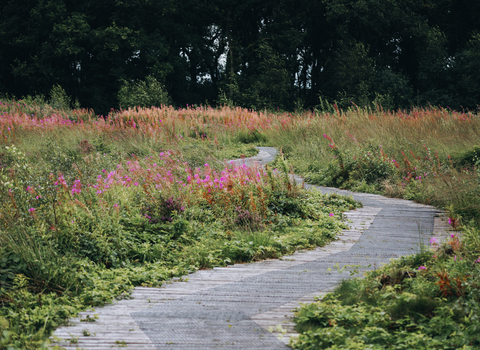Natural England, the organisation that advises the government on nature, has warned the development could have ‘potential significant effects on Danes Moss Site of Special Scientific Interest’.
The Site of Special Scientific Interest is part of the wider Danes Moss site and is the largest lowland raised bog in Cheshire. Over the past decade Cheshire Wildlife Trust, who own half the site, has made significant efforts to rewet and restore the peat to a healthy state. By doing this, the site can provide a carbon storing habitat that is rare in Cheshire.
At its closest point, the proposed South Macclesfield Development Area is just 70m away from the SSSI. With 950 houses, retail outlets and a link road being planned, Cheshire Wildlife Trust are alarmed about the potential knock-on impact to the habitat that the nature reserve provides. Any impact on the water levels on the nature reserve could undermine the Trust’s efforts to restore the moss and cause thousands of years of stored carbon to be released into the atmosphere.
Cheshire Wildlife Trust have been raising concerns about significant losses to nature on the site since the development was first proposed in 2014. One of the UK’s most threatened bird species, the willow tit, has been identified as breeding on the site since outline permission was granted. The Red-listed species has only 6% of its 1970s population remaining UK wide and the destruction of their habitat in Macclesfield could mean that they disappear from the local area for ever.
Dr Rachel Giles, Evidence and Planning Manager of Cheshire Wildlife Trust says:
‘So far, the council has made no plans to provide alternative habitat for willow tit despite the fact they have been recorded on the site. There’s also no alternative habitat planned for species such as the barn owl or the threatened small heath butterfly.
‘The key principles of maintaining a healthy natural environment include making wild spaces bigger and better connected. Developing part of an existing large area of well-connected wildlife-rich habitat simply goes against all scientific advice. We won’t know the full impacts of this development on our nature reserve or these species until it’s far too late.’
Cheshire Wildlife Trust also echo Natural England’s view that ‘the environmental significance of this development site has not been fully recognised’. The proposed development is located on lowland raised bog habitat which, when in good condition can store carbon, mitigate flooding and enhance air quality and biodiversity.
Dr Rachel adds,
‘The close connection to the existing Dane’s Moss nature reserve would make this site an ideal candidate for a wetland recovery project. There would be significant value to nature and the climate by restoring the site’s peat. If the Council were to halt the development, we’d hope that the discussions could move to improving the site for wildlife and enhancing its value as an accessible natural space for the people of Macclesfield.’
Cheshire Wildlife Trust are urging supporters to get in touch with their councillor and ask them to rethink the development. More information can be found at: https://www.cheshirewildlifetrust.org.uk/stop-south-macclesfield-development-area.

